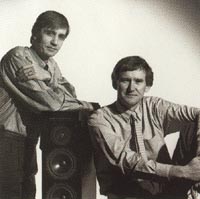 The Lecson Audio company was founded in 1972 and opened a factory in Burrell Road, St. Ives near the university town of Cambridge, England. The original team included designer Allen Boothroyd; engineer Bob Stuart (both now at Meridian) and speaker designer John Greenbank who later founded Tangent Acoustics.
The Lecson Audio company was founded in 1972 and opened a factory in Burrell Road, St. Ives near the university town of Cambridge, England. The original team included designer Allen Boothroyd; engineer Bob Stuart (both now at Meridian) and speaker designer John Greenbank who later founded Tangent Acoustics.
The company introduced the AC1 pre-amplifier and the matching AP1 amplifier then later the HL1 horn loaded loudspeaker and the SP1 loudspeaker.
Unfortunately, the original Lecson company failed just prior to initial market release. Lecson products were well reviewed by the UK and French magazines and initially the sales were high particularly after the AC1/AP1 combination won the prestigious UK Design Council Award for industrial design.
However the inefficiencies of manufacture held the company back until eventually bankruptcy resulted in 1974. The business was then bought as an investment by an Indian businessman, Mr. V. N. Singhania (via his company Simportex), whose main activity was in the buying and selling of such commodities as sugar and non-ferrous metals.
Per Stan Curtis, “The factory comprised of two side-by-side units totaling about 4,000 sq. ft. At the front were offices and one unit was devoted to production. There were actually two factory units and doors were punched through the walls to make one large unit.
The other unit was occupied by the test and inspection team and storage. Typically the company employed about 7 management and administrative staff; about ten production staff and about 7 test staff; quite a high proportion indicating both the thoroughness of the testing and also the time consuming nature of testing. Most of the team remained constant from the foundation of the company to its eventual demise.
Some words on the staffing around my time at Lecson. In the front offices you had Singhania who popped in about one day a week. There was then a secretary and a young clerical girl plus the book-keeper (accounts). Mike Harris the Sales Manager was normally out and about. In the factory there was the Production Manager and his assistant.
There were about 5 or 6 assemblers with all the board assembly work being done by housewives working at home (everything was hand- soldered; a feature that encouraged unreliability).
In the test department there were two technicians testing pre-amplifiers and two testing power-amplifiers. Finally there was myself and a service engineer. So typically around 8 management/administrative (including myself); and about 11 in manufacturing. So quite a small team which is why I called it a “Professional Cottage Industry”.
The test equipment was a mixture of Sugden and Radford low distortion oscillators and analysers and of a good standard for the era and; as already mentioned, the test and measurement routine was comprehensive with the results for each unit being kept on file.
Unusually for such a small company there was a small anechoic chamber where every single loudspeakers was tested with a full response sweep and a sensitivity & amp; an impedance check.
At the time there were several alternative audio analysers. The real cheap ‘n cheerful units were from Sugden. They were cheap but terrible to use. Lecson used these for testing the power amplifiers.
Then there were the Radford Series 2 units which were the best of the UK made stuff. Lecson used these for testing the pre-amplifiers.
Down the road at Cambridge Audio we used the semi-automatic Hewlett Packard 334A analysers which were very, very good. Then along came the Sound Technology 1700A which was from another world. Cambridge Audio re-equipped with these units and in fact became the UK distributor. I even bought one personally.
When I moved to Lecson I had changed to a 1700B and I used this for all my R&D work although the factory struggled on with its Sugden & Radford units. I never did persuade owner Singhania to buy ANY test equipment until I designed the first tuner (using my own Sound Technology 1000A generator) when he agreed to buy a 1000A for the production line.
Actually I still have the 1700B which works well, although I never use it, being an Audio Precision enthusiast for the 25 years past; and I still have the two 1000As although I don’t think they work now
It should be remembered that the Cambridge area was the UK ‘s Silicon Valley of hi-fi. Originally the home for Cambridge Audio and Quad it quickly encouraged other companies attracted by the availability of skilled labour and experienced vendors and sub-contractors.
Over the years other companies in the area included Monitor Audio loudspeakers; Lecson Audio; Lentek Electronics; Arcam Electronics; Mission loudspeakers; Cyrus electronics; Meridian electronics; Audiolab electronics; Epos loudspeakers; Avid turntables and many more; some long forgotten.”
Round One- Boothroyd & Stuart (1972 to early 1975)
Allen Boothroyd’s flat little preamp and cylindrical power amplifier were aimed straight at the heart of the lunatic fringe of wealthy audio customers in 1973. Previously a designer for Hulme, Chadwick, and Partners, Boothroyd teamed up with electronics design specialist Robert Stuart to form Lecson, located in Britain’s audio heartland of Huntingdon and very near to their chief competitor Quad.
Thrust into a world where most audio component designers were still waffling on about Quad’s orange color scheme, Lecson’ unique rectangular preamplifier and cylindrical amplifier set new design standards for audio equipment throughout the world.
Classic American wooden sleeved clunk or Japanese silver box designs immediately became second rate.
One reviewer wrote, “In the crowded audio market place dominated by one-box amplifiers with lots of knobs and no respect for the rest of the furniture, the two piece knobless system introduced last year by newcomer Lecson Audio Ltd. distinguishes itself effortlessly.
Electronically, the separation of pre-amplifying and power amplifying components is a design concept which dates from the earliest class of him enthusiasm; now it lingers on fit only a very few- top-market products and as an ideal to be discussed in hi-fi magazines. Lecson was the first manufacturer to create an entirely new industrial design idiom around this idea.”
Lecson’s managing director David Southward was determined from the start that his units should compete with the very best equipment on the market. “Our first requirement is to satisfy the technical people,” says Southward. “This is the most important thing. The image of any hi-fi product stems from its technical excellence.”
 A glimpse from Martin Robinson:
A glimpse from Martin Robinson:
“This may be a fleeting membership, since rather than being a diehard Lecson fan, I just seem to have got entangled with a small part of its history. So I’ll hang around for as long as you’ll tolerate me and hope that I can contribute a small amount to the group.
I’ll introduce my self by telling you that I moved to a village near the St. Ives factory with my family when I was a teenager. I was already keen on electronics and was fairly industrious. When I was 15 I cycled to the St Ives industrial estate and went asking for a job.
This came in the form of helping to paint the inside of an empty factory unit, vacated I believe by Sinclair before they moved to the Mill, and about to be occupied by Tek for production of their hugely successful (but I always thought rather useless) Zerostat anti static gun.
However, the job was given to me by Ted Jarvis the manager of Diamond Engineering, a small sheet metal works, I don’t know the connection except that when I subsequently went to work for Diamond, they had a plastic extrusion machine churning out the bushes that the Zerostat’s needle was set into. Diamond also were producing chassis and cases for Meridian 101/103s. I worked for pocket money at Diamond until I went to University to study engineering.
It was quite normal to have various people around who were either talking about components in production or working on prototypes. Who knows I may have see Stan at some point. I certainly remember the Lecson amps – the AP1 being made from two semi circular aluminium extrusions that slid together. I remember Allen Boothroyd and Bob Stuart as well as Len Schofield and Al Tekell (Lentek). I have a particular memory of the favourite “reference” album that got played was I’ve Got the Music In Me by Thelma Houston featuring Pressure Cooker. It wasn’t my type of music at the time, but I remember it sounded good on the what it was being played on.
I wasn’t quite ready (financially) for this type of equipment and was working my way up with the likes of Sinclair 2000 amplifier, BSR 810 turntable, and Pioneer PL12D. But eventually I found myself the owner of a 101/103 set, a Michel Focus 1/SME 3009II/Technics 205 CMK3 and the prototype Lecsons. Diamond had been making a triangular stand for these, so I helped myself to a couple of unfinished ones off the factory floor (rejects I’m sure!) and gave them a lick of aluminium paint and varnish. When I find out the place to do it, I’ll post a picture of them from that time.
I’ve listened to the Lecsons recently and, not quite what Stan has quoted for me, find that the Dalesford drivers impose a lot of colour. To my ears you can hear the timbre of the cone doping. But, I haven’t done a proper comparison test. I regret that I have not looked after them as well as I should have done, cabinet-wise. But apart from cosmetics, they are fine. I’m now under instructions to have a clear out, an so, that’s why I’ve got a few things up for sale right now. Again, many thanks for allowing me to join this group.”
Round Two: The Stan Curtis Era (1975- 1978)
Stan Curtis writes, “The original founders of the company left at this stage and Stan Curtis who was then Technical Director of Cambridge Audio was brought in as Managing Director with a brief to turn the company around. He employed a dynamic sales manager from Cambridge, Mike Harris, and set to work. Stan quickly replaced the troublesome AP1 with the more powerful AP1X and introduced the AP3 mk2 which used a substantial toroidal power transformer and gave an output close to 140 watts per channel.
 Now Lecson Systems Ltd., the new company strutted its new products at the 1976 Harrogate audio fair: The FM Tuner; the SPX speaker; and the Lynette bookshelf speaker.
Now Lecson Systems Ltd., the new company strutted its new products at the 1976 Harrogate audio fair: The FM Tuner; the SPX speaker; and the Lynette bookshelf speaker.
The new electronics were followed by the LB1 Lynette compact loudspeaker which was unusual because the baffle was angled towards the listener. This loudspeaker sold in very large quantities and became Lecson’s most successful product.
 Just prior to the launch it was to be called the “Lecson Lillette” but Stan’s girlfriend informed him that the proposed name was the same as a ladies sanitary product and so the name was quickly changed to the Lecson Lynette.
Just prior to the launch it was to be called the “Lecson Lillette” but Stan’s girlfriend informed him that the proposed name was the same as a ladies sanitary product and so the name was quickly changed to the Lecson Lynette.
He also introduced the FM1 stereo tuner which was an immediate success. The FM1 had a row of LEDs to indicate the station frequency although it was planned to offer the DR1 digital display (in a cut down AP1 case) as an optional extra.
The DR1 was fed with the local oscillator signal. Stan was keen on digital displays because he had designed the world’s first fully digital tuner whilst at Cambridge Audio. In the event only a handful of DR1s were ever built. Between one and two hundred tuners were built but the mechanical design of the LED display was troublesome both in terms of production and in terms of reliability.
One of the most interesting parts of the FM1 design was the power supply. Because of the low profile of the case there was insufficient room to fit the ideal size of reservoir capacitor so a regulated supply was designed which used a negative feedback amplifier (a simple 741 integrated circuit) to cancel out the ripple on the supply line to give a totally clean supply. This circuit was set up with a preset control so that the ripple could be completely eliminated. It worked very well indeed.
As a result of the display problems work was started on a second generation model, the SFM2, but before it was finished Stan was headhunted to found Mission Electronics; the loudspeaker manufacturer.
At this stage Lecson was doing extremely good business with a strong retailer base in the UK and exports across the world. However there were some difficulties in the USA where a former UK retailer, John Bradford, had set up in San Diego in Southern California to distribute Lecson electronics with Rogers loudspeakers (the famous LS3/5A etc.). John lacked technical support and despite the sales success of the new products he was inundated with legacy products such as the AP1, being returned for repair.
The AP1 had some design weaknesses and so was difficult to repair. Indeed at one point Stan Curtis flew to the USA for a one week sales trip and finished up spending an extra three weeks in the country fixing these amplifiers. Lecson had something like 30 to 40 dealers in the USA and they were extremely loyal and enthusiastic about the products.
Stan subsequently completed the design of the FM2 acting as a consultant. The design was largely the same as the FM1 but the frequency display was re-engineered as a plug-in module to simplify production and a new AFC (automatic frequency control) circuit was added which was really effective in pulling in the desired station when the tuning was in approximately the right place. Several hundred pieces of this tuner were manufactured over the next six months.
 The other new product was largely a precursor to the many US high-end products seen later. This was the AP4 which was a large mono-block Class A amplifier with a power output of 60 watts in Class A and 100 watts in Class AB and a maximum current output of over 30 amps.
The other new product was largely a precursor to the many US high-end products seen later. This was the AP4 which was a large mono-block Class A amplifier with a power output of 60 watts in Class A and 100 watts in Class AB and a maximum current output of over 30 amps.
 The photograph of me was taken by Derek Sutton; the then Production Manager, and almost caught me unawares. He just stepped into my office and “click”. Hence my less than amused expression.
The photograph of me was taken by Derek Sutton; the then Production Manager, and almost caught me unawares. He just stepped into my office and “click”. Hence my less than amused expression.
There is no doubt that Singhania had no grasp of hi-fi or of manufacturing and he couldn’t understand why we had “reject” components because to his eye they looked OK. One case in point was the huge number of reject AP1 boards (burned tracks etc) which could never be repaired. Every now and then when I was away seeing distributors Singhania would tell production to re-use them and then, of course, they would be rejected at first test. I got so fed up with this game that one day I put about 400 modules into boxes; drove down to the river and chucked the lot in, never to be seen again.
Next the subject of the toroidal power transformers. The standard Plessey transformer (the one with orange-brown colouring) was a superb transformer. A later transformer used black insulation. This was less expensive but an almost exact copy of the Plessey. I designed the transformers myself because this design was tricky. With such a tall transformer the side windings are unusually long and could start to “bong” after a few months. In other words the transformer would give off an audible hum.
It is hard for me to conceive of one transformer producing significantly more output than another. The volume is limited so all transformers would be the same size and they consist of a steel ribbon core and copper wire. Yet slightly better regulation at the expense of noise could be obtained by changing the winding spec. but we are talking of 5% or so. Copper wire is copper wire and at that time everybody used cores from British Steel. They made two types of ribbon. A good quality transformer steel and a lesser quality inexpensive alternative known in the trade as “crapalloy” — work it out. So all UK transformer makers worked from the same components.
First during my period at Lecson the company went from strength to strength. It was in a terrible state when I got there but we moved quickly and turned things around. I brought in Mike Harris on sales; Derek Sutton on production and Stuart Stowe on test; all ex-Cambridge Audio employees. We then had a strong team and Singhania largely left us to it. And the company started to make a profit. A small profit but a profit none the less and that is something it had never ever done before. None of the dodgy practices listed above took place during my time and all the magazine reviews were of absolutely standard equipment.
Finally I will attempt to explain how it came to pass that Howard suffered the problems he now recalls. Lecson was moving forward well and then Singhania went off to India for three months on a business trip for his other company, Simpex Ltd. (Singhania Import &xport).
Something happened there because when he got back it was apparent that suddenly all the money had gone. Our bank account was empty and we couldn’t pay bills. It seemed Singhania wanted more money because we were selling all our stock and not replacing it.
At the time I was being head-hunted which is always flattering. I could either go back to Cambridge Audio; go on to form Lentek or be a founder director of Mission. I choose the latter and quit. Mike Harris followed me out of the door a few days later and, over the next couple of months many good employees walked down the road to get jobs at Mission including the only two really competent test engineers; Stuart Stowe and Mark Rogers.
Lecson was then in a real mess and Singhania took over day to day control with disastrous consequences. All manner of strange things happened including, as Howard mentions, the virtual destruction of the dealer chain. Quality control went to pieces and within 18 months the company was in liquidation. Towards the end Singhania asked me to go in and see what could be done but the answer was nothing. There was no way back a second time.
I never got to the bottom of the money problem but something strange was going on. A couple of months after the liquidation the accountants contacted me and said they had been unable to get anywhere with Singhania who technically owned all the assets because there was a debenture in favour of Simpex who therefore stood ahead of all the suppliers who lost all their money. Apparently Singhania was too busy with his other (successful) company to be bothered with Lecson. So it was sold to me for a song.
I’ve been told by a mutual contact that Singhania got the opportunity for a really big investment and so pulled in every penny he could find. And that a couple of years later the investment paid off massively. I don’t know; it was just what I was told but it would fit the facts.”
Unfortunately once Curtis and Harris left the company lacked any senior management and the owner took over day-to-day running of the company. Sales fell and the company again failed financially in 1979.
Once the dust had settled Curtis bought the assets of the company and the brand name. Production resumed for a year until all the “work in progress” was used up but Stan Curtis was by this time the owner of Cambridge Audio so he had no time to give to Lecson. All the remaining parts were sold to Armstrong Amplifiers in London who undertook to maintain servicing facilities for existing owners.
Round Four: The Name Lives On (Part One): Paul Burell
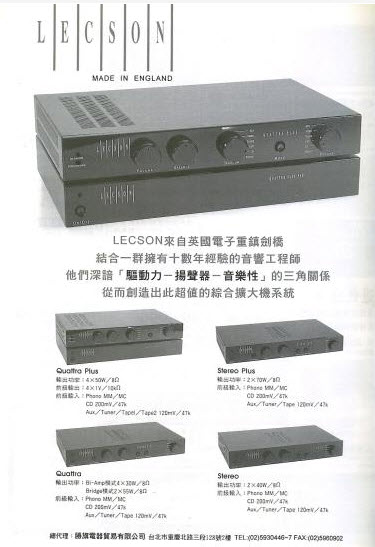 The brand was then dormant until in the mid-1980s Curtis was approached by Paul Burell with a proposal to license a brand of hi-fi electronics to be made in a factory about 100 yards away from the original Lecson factory.
The brand was then dormant until in the mid-1980s Curtis was approached by Paul Burell with a proposal to license a brand of hi-fi electronics to be made in a factory about 100 yards away from the original Lecson factory.
These Mosfet amplifiers went into production and were well received but the founder suffered serious illness (from which he was to die a few years later) and again the company floundered.
Four models have been identified: the Quattra, Quattra Plus, Stereo, and Stereo Plus. An outboard DC power supply appears to add the “Plus” moniker.
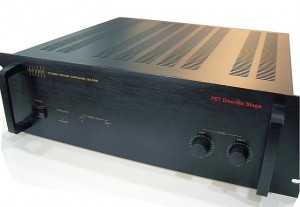 There is some controvery in Hong Kong regarding this particular range of Lecson, Audiolink Sterling, and Parasound electronics of similar vintage. Very similar OEM’d products, but not identical.
There is some controvery in Hong Kong regarding this particular range of Lecson, Audiolink Sterling, and Parasound electronics of similar vintage. Very similar OEM’d products, but not identical.
Round 5: The Name Lives On (Part Two): Debenham’s Lecson
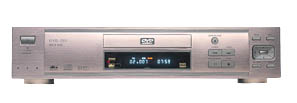 Finally in 2000 when Stan Curtis retired as Chairman of Wharfedale loudspeakers and of Quad Electronics, he revived the brand on a range of modern electronics including DVD players and home theatre systems. These were made in China but Stan had some involvement in the design work and so as a result they were favourably reviewed and sold in large numbers.
Finally in 2000 when Stan Curtis retired as Chairman of Wharfedale loudspeakers and of Quad Electronics, he revived the brand on a range of modern electronics including DVD players and home theatre systems. These were made in China but Stan had some involvement in the design work and so as a result they were favourably reviewed and sold in large numbers.
Indeed by 2001 the brand was so successful the UK department store chain Debenhams bought the brand with a view to producing its own range of consumer electronics.
However six months later Debenhams itself was bought by a private equity group and the new owners decided to get out of consumer electronics. And there the story ends for now. Many Lecson collectors searching for original parts end up with eBay searches for remote controls for these DVD players, much to their annoyance.
Personnel Update
Allen Boothroyd and Robert Stuart have successfully continued their partnership over 30 years now, having gone on to found Meridian after their Lecson stint.
David Southward has yet to be located.
Stan Curtis claims (!) to be retired after managing some of the UK’s most prominent audio companies. He is a regular contributor to this site.
Service engineer Alan McDonald subsequently left Lecson to became Manager of University Audio; the retailer in Cambridge. He then had some personal and health problems and left. He then turned up at another company but then disappeared and I was told he had died at a young age.
Mike Harris still running Moth but close to retirement. Promises to check in on this site to keep us honest from time to time
Derek Sutton retired to Cornwall.
Paul Holmes (repairs Lecson equipment) is current at Meridian
Ferdy Eastman retired; and Stan met his daughter recently. This cute teenager had turned into a middle aged mum.
Stuart Stowe went to Mission, then Wharfedale, then NXT. Left NXT but still around.
Mark Rogers went to Mission, moved on a year ago.
Andy McPherson set up his own manufacturing business.
Antony and Miguel are in Italy
A.R. Anderson (Test Engineering) is unknown
Vishwa Nath Singhania is currently the Managing Director at Simporex.

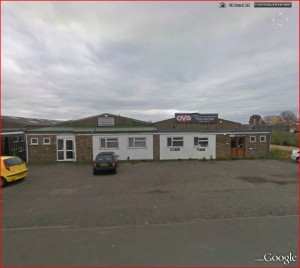
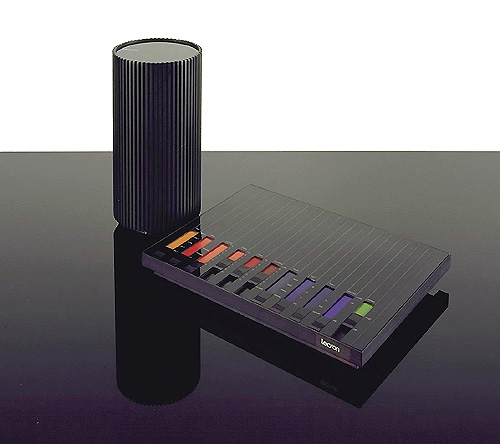
Hi Together
Have you any technical Information or brochure about the lecson stereo ?
Is the company still manufacturing ?
Service Manual would also be perfect.
Best Regards
Daniel Reidt
Switzerland
The company is no longer manufacturing equipment.
The history and technical manuals are available at lecsonaudio.com
Thanks,
John
Morning John
What a pity !
What is the procedure to Order the technical Manual (spare parts still avalaible) ?
Just send an E-Mail or … ?
Thanks
Daniel
Hi
Very interesting article. I worked for Quad, and Audiolab so remember a lot of the people mentioned. Also Al Tekell was my neighbour. It was at the time when British Audi was considered the best in the world.
One point I am sure you meant is Stan Curtis was approached by Paul Bullin and not Paul Burrell.
Regards
David
So who owns the Lecson name and trademark now?
It would be fun to relaunch the company, but I daresay start-up costs would be substantial and who knows what plans the current owners of the trademark/name would have.
Who designed the Quattra basic model.????
Paul John Bullinaria I think this was the latest director of Lescon
Vishwa Nath Singhania is currently the Managing Director at Simporex:
Not a live company.
I have just joined this group.
When I was 16 I had a summer holiday job with Lecson in the Nuffield Road, St Ives premises as a general dogsbody. I had been mad keen on electronics and HiFi for a few years, and had got to know John Dawson (founder of A&R Cambridge), but then a luminary in the CAmbridge University Tape Recorder Society and researcher into superconductivity at Cambridge University, who started his HiFi business making power amplifier modules in his backroom in his tiny Bemuda Terrace flat in Cambridge.
Back to Lecson. Somehow I got a job at Lecson over the holidays. I lived near the river in Cambridge and cycled the 3 or 4 miles out to David Southward’s house in Girton. David would then drive flat out along the old suicide lane A45 to St Ives in one of his sports cars, the most memorable, and scary, being a left hand drive Porsche. I was convinced that David was trying to set a speed record every day.
Bob Stuart gave me a task of fabricating a test rig for the AC1 preamp. I struggled with this task. His instructions were very high level. I was young. I remember having difficultybuilding a discrete quadrature oscillator. I am sure that as a result most of the work I did was assembly and odd jobs.
I left Lecson the proud owner of an AC1 preamp, maybe it was one of the prototypes. It had glass strips on it rather than the screen printed perspex. In fact I still have this preamp, though it acquired a perspex top over time. And unfortunately, today it does not work (one channel lower gain).
One of my clear memories from these days were some listening tests, done outside of Lecson but with Bob Stuart and John Dawson and others, that were set up to assess the audibility of transient intermodulation distortion by comparing AP1s with different levels of feedback. I can remember my astonishment that less feedback led to a better sound (for music). Since then I have been a firm believer in the audibility of transient intermodulation distortion.
I left for New Zealand in 1975, leaving my parents with the Lecson pre-amp and a couple of home made power amplifiers (one a tri-amp, active crossover amp for my home made speakers using John Dawson’s power amp modules). I returned in 1979
and found that Lecson was now in the hands of Stan Curtis working out of tiny premises, somewhere a little south of Huntingdon just off the A1. I took the opportunity to purchase an AP1 for my parents, so that they would have an all Lecson set of kit. I think this is also when the AC1 got it perspex top.
Recently my parents gave me their Lecson kit. The preamp has a fault with it, and so I chose not to use it, but the power amplifier seemed OK. However, I noticed the stereo image was not clear, and this puzzles me. I put the AP1 aside. I thought perhaps that this power amp had been modified for bridge use, such that the phase of one of the inputs was reversed. Today, I took it apart, and both channels appear to be identical. Any ideas, anyone?
Along the years, I acquired another AP1, which the previous owner had bastardized. So it looks like I have a hoard of dysfunctional Lecson equipment.
Nice to see this extremely professional web site.
The site looks good John. Thank you for disposing of the riff-raff.
Thanks for giving us eccentrics a place to hang out and chat about our favorite kit.
Jack Ward
Likewise, much appreciated!
All going well here John. Thank you for your on-going commitment to these wonderful bits of kit.
Cheers,
Tim
I too was involved with the Cambridge University Tape Recording Society (“CUTRS”) and was responsible for tape sales which mostly meant having boxes of discounted Agfa tape clogging up my room on 1974-77. John Dawson and Chris Evans were heroes of the moment with their A60 and guest speakers included such luminaries as Peter Walker, Angus McKenzie plus of course Stan. I remember Bob Stuart coming to my college to deliver an AP1/AC1 to my room mate, I would have liked one as well but had just sunk most of my student grant into a Cambridge P110.
It was a heady time with so much going on up the road in St Ives and Huntingdon and St Ives even supported a hi-fi dealership where I (using my next grant cheque) was able to buy a Revox A77 for £395. I still have the receipt though sadly not the machine which I sold for silly money in around 1983.
Later I went on to do some development work, including some for Stan which came to nothing after his business collapsed and he got into a spot of legal “difficulties”. That work moved to Hi-Fi markets where I developed a digital pre-amp which was to be used to relaunch the Leak brand. Sadly, they ran out of money, simply not enough resources to get the job done.
That tech corridor has undergone so much change. Many companies have been and gone and been mopped up by a conglomerate. There’s still Cyrus hanging on and Meridian of course who have attracted external finance but have moved decided up-market to serve the luxury markets in the US and China. What keeps them afloat I suspect is their DSP IP which provides added value compared to simple board stuffing.
I’m busy renovating a Quad 33/303/FM3, which lovely in their simplicity compared to modern stuff and actually sounding pretty good still.
I should also have mentioned I did work for Mission at their fancy factory in Stonehill, Huntingdon with a picture of local MP John Major opening it in the foyer. So much ambition until one of the Azima brothers decided NXT was all that mattered. That factory (and Meridian used to be opposite) is now a shadow of its former self. And there’s a problem. If you have a Mission loudspeaker, I doubt you can get it repaired, but a company like Celef Audio/ProAc were able to supply parts to fix my 15 year old speakers. I’ve just got in to Meridian Active LS but with a certain trepidation about how long they will be around to look after them.
Pingback: av2day.com » Blog Archive » Remembering futuristic designs from the past